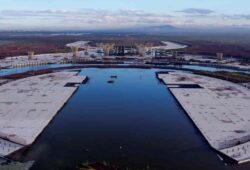With Alaskans joking about the mosquito being their “state bird”, you may be wondering – so why are there so many mosquitoes in Alaska, anyway?
Compared with other parts of the world, mosquitoes seem to be a very big issue in this state.
Is it the weather? Is it their location on the globe?
What really is the big reason – or reasons – why mosquitoes are quite common in this part of the world? Let’s investigate and get the answer once and for all!
Contents
Why Are There So Many Mosquitoes In Alaska?
Mosquitoes are rather relentless in Alaska, and many people are left wondering why there are so many of them in this state.
It is a common concern when the wind has dropped and the endless summer heat of the sun takes over. Thus, the ponds are no longer the frozen tundra it once was. And during this time of the year, mosquitoes begin to emerge in the Arctic.
According to researchers, there are simply not a whole lot of animals for these mosquitoes to feast on. So, as expected, they simply go after the people, which makes them so much of a nuisance.
Additionally, climate change has some contributing factors to this problem with mosquitoes. When the temperatures get warmer throughout the Arctic, mosquitoes grow faster after emerging. To make things worse, they are able to outlive other winged pests.
This is why they are the bane of not only humans but also other mammals such as elks, reindeer, and caribou in the state. Once the temperature goes as low as 2 degrees Celsius, young mosquitoes are capable of surviving and reaching their adult stage by about 53 percent.
Fortunately, Arctic mosquitoes are not the ones that cause human diseases. Yet, the change in climate spells out disaster for caribou but is beneficial to the rest of the tundra as mosquitoes pollinate plants. Thus, they offer more food for birds and other winged creatures such as insects.
What Causes More Mosquitoes To Hatch And Populate

When the Arctic gets warmer, the frozen lakes and ponds on the tundra begin to melt. This usually happens sooner now because of the changes in climate. And along with this situation comes the hatching of more mosquitoes.
It is once the frozen waters are thawed that mosquitoes begin to hatch. But aside from this, warming all over the globe has caused these pests to develop at a much faster rate. Hence, they are able to survive better even in their earlier life stages.
Even if beetles that feed on mosquitoes grow just as fast, mosquitoes are capable of reaching adulthood and in such impressive numbers.
Read More: Important Safety Procedures For Using A Liquid Fuel Stove You Should Know!
Impact On Mosquito Infestation In Alaska
It is not just the humans that are heavily impacted by these mosquitoes in Alaska.
Yes, it is quite an annoying experience to deal with these mosquitoes that constantly seem to want to bite you. Yet, the caribou gets attacked by massive swarms of mosquitoes, as well.
When this happens, these big mammals refuse to eat, which also causes their population to decline.
With such an issue on mosquitoes, it is not unheard of to have about a hundred mosquitoes attacking their victim. This is why you can just expect to be entirely covered by a massive swarm of these stinging pests in seconds.
Overall, the population of caribou, and even the deer, has declined slowly because of such harassment they get from these pests. Mammals decide to escape from mosquitoes by heading over to icy areas just to evade the attack.
Unfortunately, this also impacts their desire to eat. This is why as mosquito attacks increase, the population of these big mammals decreases.
And over time, this will impact ecology’s balance and affect people’s food source.




